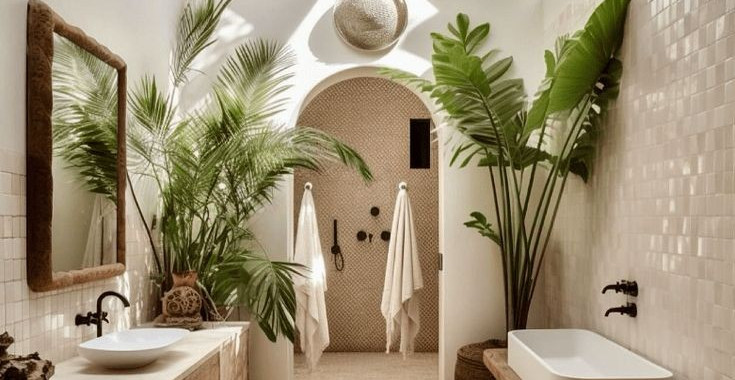Bringing Nature into Our Homes, Restaurants, and Hotels by 2025
As we approach 2025, a transformative design trend is reshaping how we interact with our environments, from the comfort of our homes to the ambiance of restaurants and the luxury of hotels: biophilic design. This innovative approach emphasizes a profound connection with nature, inviting the outdoors into our living spaces and commercial settings. By incorporating organic shapes, natural materials, and soft lighting, biophilic design creates atmospheres that are inviting, calming, and rejuvenating, fundamentally changing the way we experience interior spaces.
The Essence of Biophilic Design
At its core, biophilic design seeks to bridge the gap between indoor environments and the natural world. This trend is not merely about aesthetics; it’s about fostering a sense of well-being and tranquility in homes, restaurants, hotels, and even retail spaces. It focuses on incorporating nature-inspired elements—organic forms, greenery, natural light, and earthy textures—to create spaces that are not only visually appealing but also emotionally nourishing. Biophilic design provides sanctuaries where individuals can unwind, reconnect with nature, and find respite from the fast pace of modern life.
The Benefits of Biophilic Design
Biophilic design offers a wide range of benefits that go beyond visual appeal, influencing everything from mental health to economic outcomes:
1. Enhanced Mental Well-Being: Exposure to natural elements has been shown to significantly improve mood and reduce symptoms of stress and anxiety. By incorporating elements like plants, water features, and natural light, biophilic design promotes mental clarity and emotional balance, making it a valuable addition to any space, whether it’s a cozy home or a bustling restaurant.
2. Improved Air Quality: Incorporating plants and natural materials into interiors can improve air quality by filtering toxins and increasing oxygen levels. This is especially beneficial in places where people spend extended periods, such as homes, restaurants, and hotels. The enhanced air quality contributes to better health, reduced fatigue, and overall well-being.
3. Increased Productivity and Creativity: Natural environments stimulate the mind, enhancing creativity and cognitive function. For restaurants and hotels, a biophilic design can inspire innovative dining experiences and memorable stays, encouraging guests to return and share their experiences. In retail spaces, it can improve customer engagement, making shopping more enjoyable and encouraging longer visits.
4. Enhanced Economic Value: From a business perspective, biophilic design can significantly impact profitability. Restaurants and hotels that incorporate biophilic elements can attract more customers and boost satisfaction, leading to repeat business and positive reviews. In retail, creating a natural, welcoming environment can increase customer spending and time spent in the store.
Achieving the Biophilic Look Across Different Spaces
Achieving a biophilic design involves more than just adding a few plants. It’s about creating a cohesive environment that integrates natural elements seamlessly into the interior design. Here’s how you can achieve this look in homes, restaurants, hotels, and retail spaces:
1. Interior Homes: Crafting a Personal Sanctuary
In residential interiors, biophilic design focuses on creating a peaceful and rejuvenating environment. Use natural materials such as reclaimed wood, stone, and clay for furniture and decor. Incorporate organic shapes in sofas, tables, and lighting fixtures to create a flowing, harmonious space. Large windows that let in plenty of natural light, along with strategically placed mirrors to reflect outdoor views and enhance the connection to nature. Add plenty of indoor plants, from small potted herbs to larger trees, to purify the air and create a serene atmosphere.
2. Restaurants: Enhancing the Dining Experience
In restaurants, ambiance is as crucial as the menu. A biophilic design creates a calming and welcoming environment, encouraging diners to linger longer, which can lead to increased sales. Opt for natural materials like wooden tables, stone countertops, and wicker chairs. Green walls, hanging plants, and potted herbs not only improve air quality but also add an aesthetic touch that resonates with guests. Soft, ambient lighting that mimics natural light helps create a cozy dining atmosphere, making the space feel like a natural extension of the outdoors.
3. Hotels: Creating Memorable Guest Experiences
In the hospitality industry, the guest experience begins the moment they enter the lobby. Biophilic design can transform hotel interiors by integrating natural elements throughout, from lush indoor gardens and green walls in the lobby to organic-shaped furniture in guest rooms. Natural materials like bamboo, cork, and reclaimed wood can be used for furniture and decor, creating a warm and inviting environment. Soft, dimmable lighting and water features that produce soothing sounds further enhance the calming atmosphere, making the hotel a sanctuary for relaxation and rejuvenation.
4. Retail Spaces: Engaging and Inviting Environments
Biophilic design can also transform retail environments, making them more engaging and inviting for customers. Natural materials, organic shapes, and ample greenery can reduce shopper fatigue, encourage longer visits, and increase sales. Green walls, indoor plants, and natural light can create a unique sensory experience that makes the space memorable. A thoughtful layout that guides customers intuitively through the store, combined with soft, warm-toned lighting, can create a calm and pleasant shopping environment that stands out in a competitive market.
In conclusion by thoughtfully integrating biophilic design elements into homes, restaurants, hotels, and retail spaces, we can create environments that not only enhance aesthetic appeal but also promote well-being and mindfulness. As we move into 2025, embracing biophilic design offers a unique opportunity to reconnect with nature and create peaceful havens that foster relaxation, creativity, and economic value. Whether you are redesigning a residential space, crafting a memorable dining experience, or providing a soothing hotel atmosphere, biophilic design is a powerful tool to transform any environment into a sanctuary of serenity.


































Comments